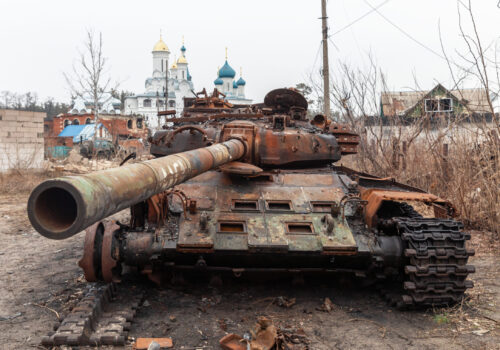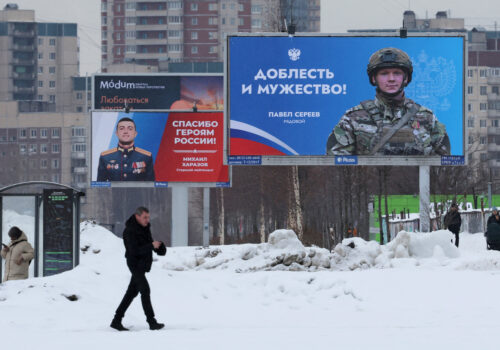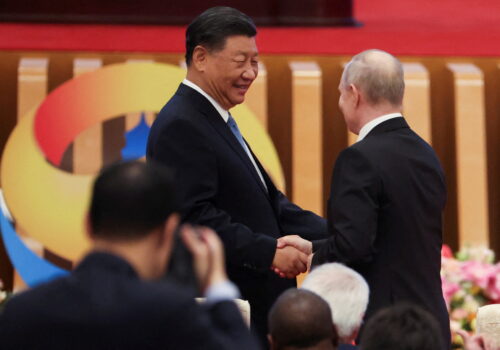Russia’s blocked assets: A ‘non-collateral collateral’ plan could be the way forward
Shortly after the second anniversary of Russia’s full-scale invasion of Ukraine on February 24 comes the second anniversary of Western countries imposing an unprecedented package of sanctions on Russia. The boldest measure within this—the immobilization of the reserves that Russia’s central bank was storing in the West—was designed to cause such shock and awe to the Russian financial system that the Kremlin might just reconsider its invasion. The policy did force Moscow to implement capital controls, which it had long sought to avoid. But these have served Moscow’s short-term goal and helped the country to withstand the initial shock of sanctions and keep funding its illegal war.
The architects of the initial sanctions package were focused on the immediate concern and less on the long term. And yet, ahead of the grim two-year anniversary, what to do with the blocked reserves has been one of the key issues that Group of Seven (G7) members and like-minded capitals are debating. All the governments involved originally took a cautious approach, believing the immobilization was already a risk with consequences that could not then be fully appreciated. This changed as the Biden administration began struggling to convince Congress to pass additional funding for Ukraine in September 2023.
Since then, without officially backing seizure, the United States has discreetly pushed for the G7 to find a legal path forward with Russia’s assets. The United Kingdom’s new foreign secretary, David Cameron, has been an especially vocal supporter and oddly dismissive (for a former Conservative prime minister) of the counterarguments based on precedential risk. The exposure of the United Kingdom and of its pound sterling is far from zero, so some allies may be wondering whether London is just trying to hide behind Paris, Berlin, and the European Central Bank, or perhaps even kill seizure by incompetently arguing in its favor. This author would never engage in such conspiracy theories.
Progress is indeed being made on the very innovative alternatives that could bring more funding to Ukraine much faster.
Despite this flurry of activity ahead of the second anniversary and opposition leader Alexei Navalny’s death, the US, UK, and EU statements on new sanctions this week don’t suggest any progress toward the seizure of Russia’s blocked reserves. Instead, the language being used by all sides as the anniversary approaches is instead aligning around “unlocking the value” of immobilized sovereign assets. Progress is indeed being made on the very innovative alternatives that could bring more funding to Ukraine much faster.
The European Commission’s plan to use the interest income from the immobilized assets has advanced despite the European Central Bank’s initial opposition. On February 12, the Council of the European Union (EU) released conclusions that prevent Euroclear and other central securities depositories from disposing the extraordinary profits made on immobilized Russian assets from now on. Though some details still need to be worked out, these profits could next be added to the EU’s financial support for Ukraine’s recovery and reconstruction. The EU would be taking a risk by doing this. Depending on each security contract, Russia’s central bank has a more-or-less strong legal claim to the interest income of the immobilized asset, and given the amount of money at stake, it will no doubt test this in courts.
There have also been high-level consultations involving top teams at the European Commission and US Treasury on how to utilize the principal without seizing it. The G7 leaders’ statement last year guaranteeing that the money will not become available to Russia unless and until it leaves Ukraine and pays compensation (worth more than the $300 billion immobilized in the West) now offers an opportunity to tell the markets that the principal will never return to Russia and will be transferred to Ukraine with Moscow’s consent someday.
This soft guarantee could reassure markets and help Ukraine borrow or at least roll the significant portion of its debt that is due in September. It doesn’t amount to using the principal as collateral, which would imply the principal changing hands without Russia’s consent and create the same risks as outright seizure. But, given the immobilized reserves won’t become Ukraine’s collateral, the teams working on this are also considering sovereign guarantees against the measure not working, even several decades in the future when Russia hopefully has a new leader and a new regime. While more than two-thirds of the immobilized assets are currently in the EU, Brussels is more likely to support sovereign guarantees if the risk is shared fifty-fifty between Europe and North America.
Washington may view such a plan as acceptable, given that it has pushed behind the scenes for the more radical option of seizing Russia’s immobilized reserves. It is also possible that UK gilts and US Treasury bonds were bought by Russia’s central bank using Euroclear’s platform and, once paid on maturity, have also accumulated with Euroclear in Belgium. This would explain the mismatch between the Russian central bank’s November 2021 database, which suggested that $38 billion of its reserves were kept in the United States, and consistent reports since the invasion saying that only $8 billion are in the United States. If Moscow did purchase US Treasuries through Euroclear, then leaders in Washington might be more willing to accept a split of sovereign guarantees with the EU that is closer to fifty-fifty that to two-thirds made by Europeans.
There haven’t been any substantial hints at this “non-collateral collateral” work stream in the new sanctions packages announced by the sanctions-wielding coalition on Friday. Expect more to surface soon. Seizing Russia’s immobilized reserves is a step the main custodians of the money are just not prepared to take for now. But everyone involved wants to get more funding to Ukraine as soon as possible.
Charles Lichfield is the deputy director and C. Boyden Gray senior fellow, of the Atlantic Council’s GeoEconomics Center.
Further reading
Fri, Feb 23, 2024
Making Russia pay for the invasion of Ukraine
UkraineAlert By Paul Grod
Using frozen Russian assets to fund Ukraine’s resistance and recovery is morally justified and would also ease the financial burden on Western economies, writes Paul Grod.
Fri, Feb 23, 2024
The toll on Russia from its war in Ukraine, by the numbers
New Atlanticist By Atlantic Council experts
Our experts quantify the staggering self-inflicted wounds Russia has suffered since Putin launched the full-scale invasion of Ukraine.
Thu, Feb 22, 2024
Chinese exports have replaced the EU as the lifeline of Russia’s economy
Econographics By Niels Graham
Two years after the initial invasion, Russia’s imports have stabilized. New industrial and consumer exports from from China have replaced trade from the US, EU, and G7.
Image: Munich Security Conference Annalena Baerbock Buendnis 90 Die Gruenen , Federal Foreign Minister, photographed at the meeting of the G7 Foreign Ministers Munich, 17 02 2024



